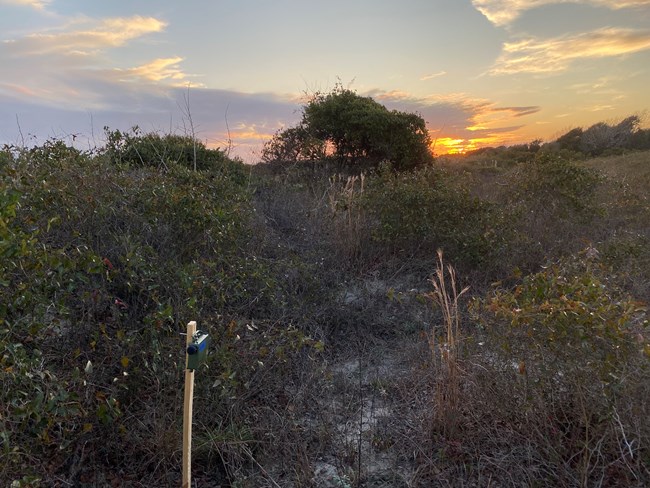
NPS photo / SECN staff

NPS photo / Michael Parrish
Overview
Fort Sumter and Fort Moultrie National Historical Park is located in Charleston, South Carolina. The park is comprised of the Fort Sumter unit at the mouth of Charleston Harbor and the Fort Moultrie unit located on Sullivan’s Island. Sullivan’s Island is a heavily developed barrier island, separated from the mainland by salt marsh and tidal creeks. The island is connected to the mainland by two large highway bridges. Fort Sumter is relatively small, and is primarily managed for its important cultural resources. The Fort Moultrie unit contains the majority of the park’s terrestrial natural resources, including a roughly 17-hectare (42 acres) scenic easement comprised of a small beachfront with dunes dominated by sea oats (Uniola paniculata) and a patch of live oak (Quercus virginiana) maritime forest containing a nature trail. The entire area—but particularly the beach and trail—experiences high intensity human activity. An additional 1.5 hectare (3.7 acres) easement is located approximately 1 kilometer (0.62 mile) east of the main Fort Moultrie unit, and is primarily in beach and dunes, proximate to the Sullivan’s Island Lighthouse.
The Southeast Coast Network conducts the following monitoring at Fort Sumter and Fort Moultrie National Historical Park:
- Landbird community monitoring and Vocal anuran community monitoring is conducted on a rotating schedule every three years. These wildlife communities play critical roles in park ecosystems and interact with several trophic levels of food webs. The network uses automated recording devices (ARDs) to collect vocalization data during mornings and evenings in the spring, which are analyzed by bioacoustics specialists. Data collected from these vital sign monitoring efforts help assess the ecological integrity and diversity of park areas and how communities and park conditions may change over time. The landbird and vocal anuran monitoring efforts in network parks began in 2012.
| Vital Signs | Examples of Measurements |
|---|---|
| Landbird and Vocal Anuran Communities | Species occurrence, distribution |
Source: NPS DataStore Collection 4032 (results presented are a subset). To search for additional information, visit the NPS DataStore.
Source: NPS DataStore Collection 4030 (results presented are a subset). To search for additional information, visit the NPS DataStore.
Source: NPS DataStore Collection 4031 (results presented are a subset). To search for additional information, visit the NPS DataStore.
Source: NPS DataStore Collection 9584. To search for additional information, visit the NPS DataStore.
Source: NPS DataStore Collection 4034 (results presented are a subset). To search for additional information, visit the NPS DataStore.
Source: NPS DataStore Collection 4033 (results presented are a subset). To search for additional information, visit the NPS DataStore.
Source: NPS DataStore Collection 9591. To search for additional information, visit the NPS DataStore.
Last updated: November 11, 2024
